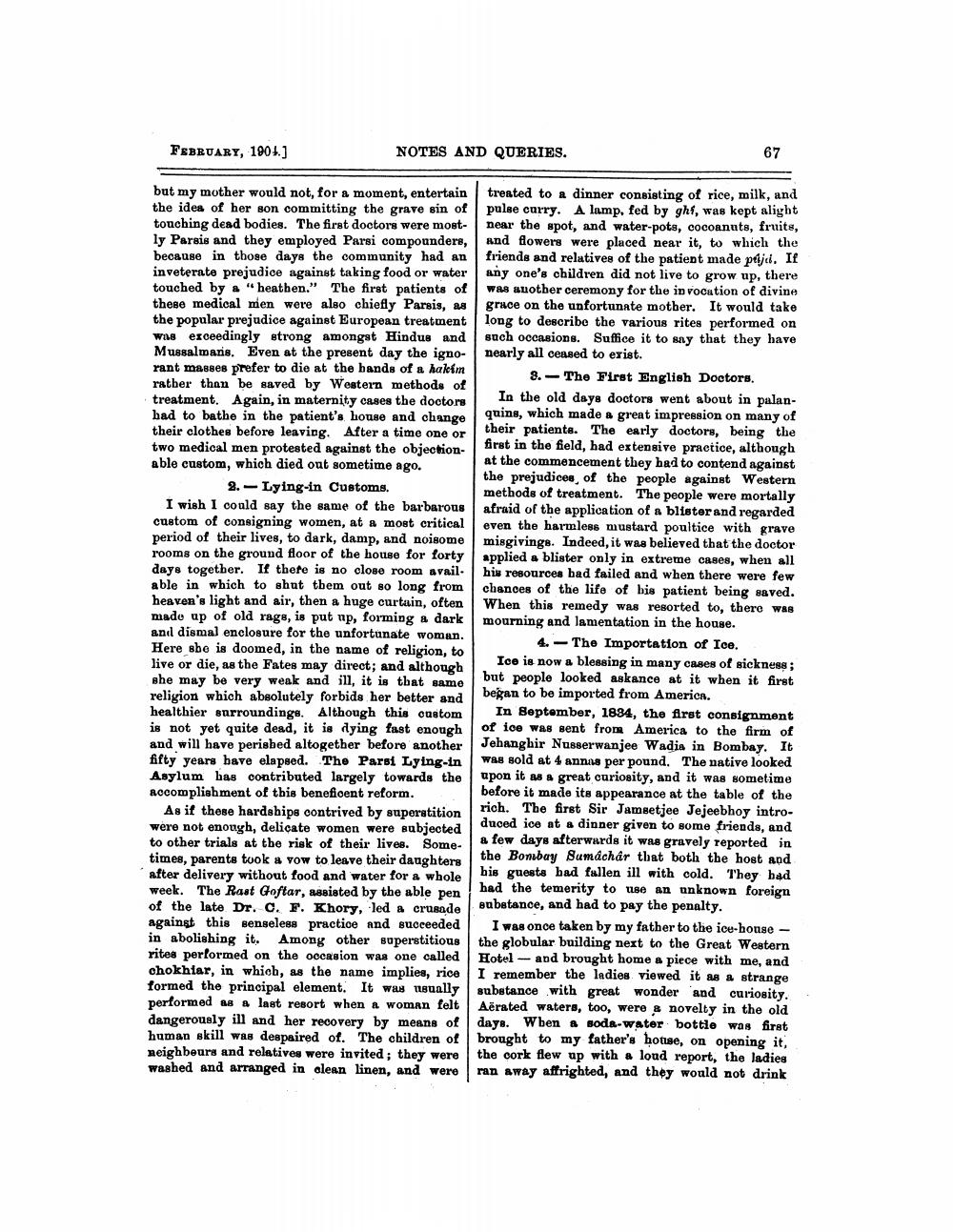________________
FEBRUARY, 190+.]
but my mother would not, for a moment, entertain the idea of her son committing the grave sin of touching dead bodies. The first doctors were mostly Parsis and they employed Parsi compounders, because in those days the community had an inveterate prejudice against taking food or water touched by a "heathen." The first patients of these medical men were also chiefly Parsis, as the popular prejudice against European treatment was exceedingly strong amongst Hindus and Mussalmans. Even at the present day the ignorant masses prefer to die at the hands of a hakim rather than be saved by Western methods of treatment. Again, in maternity cases the doctors had to bathe in the patient's house and change their clothes before leaving. After a time one or two medical men protested against the objectionable custom, which died out sometime ago.
NOTES AND QUERIES.
2. Lying-in Customs.
I wish I could say the same of the barbarous custom of consigning women, at a most critical period of their lives, to dark, damp, and noisome rooms on the ground floor of the house for forty days together. If there is no close room avail. able in which to shut them out so long from heaven's light and air, then a huge curtain, often made up of old rags, is put up, forming a dark and dismal enclosure for the unfortunate woman. Here she is doomed, in the name of religion, to live or die, as the Fates may direct; and although she may be very weak and ill, it is that same religion which absolutely forbids her better and healthier surroundings. Although this custom is not yet quite dead, it is dying fast enough and will have perished altogether before another fifty years have elapsed. The Parsi Lying-in Asylum has contributed largely towards the accomplishment of this beneficent reform.
As if these hardships contrived by superstition were not enough, delicate women were subjected to other trials at the risk of their lives. Some
times, parents took a vow to leave their daughters after delivery without food and water for a whole week. The Rast Goftar, assisted by the able pen of the late Dr. C. F. Khory, led a crusade against this senseless practice and succeeded in abolishing it. Among other superstitious rites performed on the occasion was one called chokhiar, in which, as the name implies, rice formed the principal element. It was usually performed as a last resort when a woman felt dangerously ill and her recovery by means of human skill was despaired of. The children of neighbours and relatives were invited; they were washed and arranged in clean linen, and were
67
treated to a dinner consisting of rice, milk, and pulse curry. A lamp, fed by ghf, was kept alight near the spot, and water-pots, cocoanuts, fruits, and flowers were placed near it, to which the friends and relatives of the patient made paji. If any one's children did not live to grow up, there was another ceremony for the in vocation of divine grace on the unfortunate mother. It would take long to describe the various rites performed on such occasions. Suffice it to say that they have nearly all ceased to exist.
3.The First English Doctors.
In the old days doctors went about in palanquins, which made a great impression on many of their patients. The early doctors, being the first in the field, had extensive practice, although at the commencement they had to contend against the prejudices of the people against Western methods of treatment. The people were mortally afraid of the application of a blister and regarded even the harmless mustard poultice with grave misgivings. Indeed, it was believed that the doctor applied a blister only in extreme cases, when all his resources had failed and when there were few chances of the life of his patient being saved. When this remedy was resorted to, there was mourning and lamentation in the house.
4. The Importation of Ice.
Ice is now a blessing in many cases of sickness; but people looked askance at it when it first began to be imported from America.
In September, 1884, the first consignment of ice was sent from America to the firm of Jehanghir Nusserwanjee Wadia in Bombay. It was sold at 4 annas per pound. The native looked upon it as a great curiosity, and it was sometime before it made its appearance at the table of the rich. The first Sir Jamsetjee Jejeebhoy introduced ice at a dinner given to some friends, and a few days afterwards it was gravely reported in the Bombay Sumáchár that both the host and his guests had fallen ill with cold. They had had the temerity to use an unknown foreign substance, and had to pay the penalty.
I was once taken by my father to the ice-housethe globular building next to the Great Western Hotel and brought home a piece with me, and I remember the ladies viewed it as a strange substance with great wonder and curiosity. Aerated waters, too, were a novelty in the old days. When a soda-water bottle was first brought to my father's house, on opening it, the cork flew up with a loud report, the ladies ran away affrighted, and they would not drink




